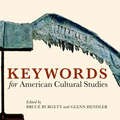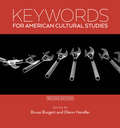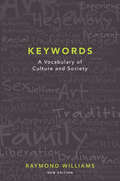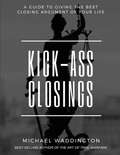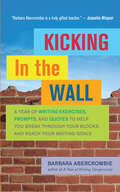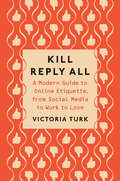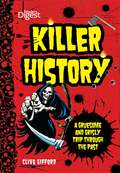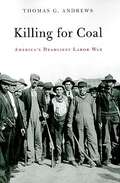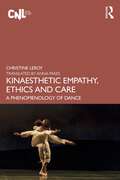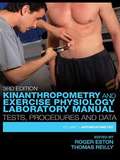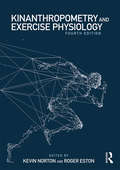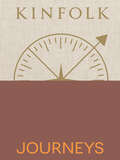- Table View
- List View
Keywords for American Cultural Studies
by Glenn Hendler Bruce BurgettExplore the Keywords Collaborative interactive website at keywords.nyupress.orgAccording to the Oxford English Dictionary, a "keyword" is "a word that is of great importance or significance." On the web, "keywords" organize vast quantities of complex information. Keywords for American Cultural Studies offers these features and more to its readers, providing indispensable meditations on terms and concepts used in cultural studies, American studies, and beyond.Collaborative in design and execution, Keywords for American Cultural Studies collects sixty-four new essays from interdisciplinary scholars, each on a single term such as "America," "body," "ethnicity," and "religion." Alongside "community," "immigration," "queer," and many others, these words are the nodal points in many of today's most dynamic and vexed discussions of political and social life, both inside and outside of the academy.Here are essays by scholars working in literary studies and political economy, cultural anthropology and ethnic studies, African American history and performance studies, gender studies and political theory.Some entries are explicitly argumentative, others are more descriptive. Throughout, readers will find clear, challenging, critically engaged thinking and writing. Keywords for American Cultural Studies provides an accessible A-to-Z survey of prevailing academic buzzwords, and a flexible tool for carving out new areas of inquiry. It is equally useful for college students who are trying to understand what their teachers are talking about, for general readers who want to know what's new in scholarly research, and for professors who just want to keep up.Contributors: Vermonja R. Alston, Lauren Berlant, Mary Pat Brady, Laura Briggs, Bruce Burgett, Christopher Castiglia, Russ Castronovo, Eva Cherniavsky, Krista Comer, Micaela di Leonardo, Brent Hayes Edwards, Robert Fanuzzi, Rod Ferguson, Shelley Fisher Fishkin, Elizabeth Freeman, Kevin Gaines, Rosemary Marangoly George, Kirsten Silva Gruesz, Sandra M. Gustafson, Matthew Pratt Guterl, Judith Halberstam, Glenn Hendler, Grace Kyungwon Hong, June Howard, Janet R. Jakobsen, Susan Jeffords, Walter Johnson, Miranda Joseph, Moon-Ho Jung, Carla Kaplan, David Kazanjian, Kanta Kochhar-Lindgren, Eric Lott, Lisa Lowe, Eithne Luibhéid, Susan Manning, Curtis Marez, Meredith L. McGill, Timothy Mitchell, Fred Moten, Christopher Newfield, Donald E. Pease, Pamela Perry, Carla L. Peterson, Vijay Prashad, Chandan Reddy, Bruce Robbins, David F. Ruccio, Susan M. Ryan, David S. Shields, Caroline Chung Simpson, Nikhil Pal Singh, Siobhan B. Somerville, Amy Dru Stanley, Shelley Streeby, John Kuo Wei Tchen, Paul Thomas, Priscilla Wald, Michael Warner, Robert Warrior, Alys Eve Weinbaum, Henry Yu, George Yúdice, and Sandra A. Zagarell.
Keywords for American Cultural Studies, Second Edition
by Glenn Hendler Bruce BurgettSince its initial publication, scholars and students alike have turned to Keywords for American Cultural Studies as an invaluable resource for understanding key terms and debates in the fields of American studies and cultural studies. As scholarship has continued to evolve, this revised and expanded second edition offers indispensable meditations on new and developing concepts used in American studies, cultural studies, and beyond. It is equally useful for college students who are trying to understand what their teachers are talking about, for general readers who want to know what's new in scholarly research, and for professors who just want to keep up. Designed as a print-digital hybrid publication, Keywords collects more than 90 essays--30 of which are new to this edition--from interdisciplinary scholars, each on a single term such as "America," "culture," "law," and "religion." Alongside "community," "prison," "queer," "region," and many others, these words are the nodal points in many of today's most dynamic and vexed discussions of political and social life, both inside and outside of the academy. The Keywords website, which features 33 essays, provides pedagogical tools that engage the entirety of the book, both in print and online. The publication brings together essays by scholars working in literary studies and political economy, cultural anthropology and ethnic studies, African American history and performance studies, gender studies and political theory. Some entries are explicitly argumentative; others are more descriptive. All are clear, challenging, and critically engaged. As a whole, Keywords for American Cultural Studies provides an accessible A to Z survey of prevailing academic buzzwords and a flexible tool for carving out new areas of inquiry. Visit keywords.nyupress.org for online essays, teaching resources, and more.
Keywords for Environmental Studies (Keywords #3)
by David N. Pellow William A. Gleason Joni AdamsonIntroduces key terms, quantitative and qualitative research, debates, and histories for Environmental and Nature StudiesUnderstandings of “nature” have expanded and changed, but the word has not lost importance at any level of discourse: it continues to hold a key place in conversations surrounding thought, ethics, and aesthetics. Nowhere is this more evident than in the interdisciplinary field of environmental studies. Keywords for Environmental Studies analyzes the central terms and debates currently structuring the most exciting research in and across environmental studies, including the environmental humanities, environmental social sciences, sustainability sciences, and the sciences of nature. Sixty essays from humanists, social scientists, and scientists, each written about a single term, reveal the broad range of quantitative and qualitative approaches critical to the state of the field today. From “ecotourism” to “ecoterrorism,” from “genome” to “species,” this accessible volume illustrates the ways in which scholars are collaborating across disciplinary boundaries to reach shared understandings of key issues—such as extreme weather events or increasing global environmental inequities—in order to facilitate the pursuit of broad collective goals and actions. This book underscores the crucial realization that every discipline has a stake in the central environmental questions of our time, and that interdisciplinary conversations not only enhance, but are requisite to environmental studies today.Visit keywords.nyupress.org for online essays, teaching resources, and more.
Keywords in Criminology: A Cultural Dictionary
by Vincenzo RuggieroTaking inspiration from the classic text by Raymond Williams, Keywords in Criminology reflects on the language used by criminologists and offers a one‑stop guide to core concepts in the discipline. Written for the budding Criminology student, it offers a specialized but plain dictionary for a specialized discipline.From Abolitionism to Xenophobia, the entries unveil the ambiguities and conflicting interpretations of the concepts discussed, and explore their historical context, their analytical use, adoption or critical rejection. The original formulation of each concept is examined along with the practices the concept has shaped, and the favourable and unfavourable outcomes it has generated. Keywords in Criminology is a handy and pithy companion for any Criminology student. It offers excellent supplementary reading for core courses on criminological, social and cultural theory.
Keywords: A Vocabulary of Culture and Society
by Raymond WilliamsFirst published in 1976, Raymond Williams' highly acclaimed Keywords: A Vocabulary of Culture and Society is a collection of lively essays on words that are critical to understanding the modern world. In these essays, Williams, a renowned cultural critic, demonstrates how these key words take on new meanings and how these changes reflect the political bent and values of our past and current society. He chose words both essential and intangible--words like nature, underprivileged, industry, liberal, violence, to name a few--and, by tracing their etymology and evolution, grounds them in a wider political and cultural framework. The result is an illuminating account of the central vocabulary of ideological debate in English in the modern period. This edition features a new original foreword by Colin MacCabe, Distinguished Professor of English and Literature, University of Pittsburgh, that reflects on the significance of Williams' life and work. Keywords remains as relevant today as it was over thirty years ago, offering a provocative study of our language and an insightful look at the society in which we live.
Kick-Ass Closings: A Guide To Giving The Best Closing Argument Of Your Life
by Barry Scheck Gerry Spence Johnnie Cochran Clarence Darrow James Bell Mark Geragos Jose Baez Michael Waddington Eric Romano Jerome Buting Robert Casale Dean Strang Ian Friedman Cheney Mason Brian Bieber Stacy Walsh Alexandra Gonzalez-Waddington Paul Bergrin Mark O'Mara Thomas Mesereau Timothy BileckiKick-Ass Closings is a powerful resource for new and experienced criminal defense lawyers, so they can deliver devastating closing arguments with minimal prep time. This book provides a simple and straightforward template that can be used in any criminal trial and hundreds of sample closing arguments that can be crafted to fit the facts of your case. Used properly, this book can save you time, and increase the power and effectiveness of your closing arguments. More importantly, it will help save lives, and protect the freedom of those whom we defend.
Kicking In the Wall: A Year of Writing Exercises, Prompts, and Quotes to Help You Break Through Your Blocks and Reach Your Writing Goals
by Barbara AbercrombieWhen Patti Smith was plagued with writer’s block — “scattered and stymied, surrounded by unfinished songs and abandoned poems” — playwright Sam Shepard advised her, “When you hit a wall, just kick it in.” In these pages, Abercrombie shows readers how to do just that. Like a workout with a top trainer, her writing exercises warm up, stretch, and build creative muscle. Quotes from famous writers inspire each day’s exercise. Though Abercrombie says readers need only commit five minutes to each exercise, she writes, “I’ve seen novels, memoirs, and many essays get started” in those five minutes, “and a lot ended up being published.” Her playful, powerful method is ideal — maybe even essential — fuel for writers trying to get off the starting block, persevere through challenges, and cross their personal creativity finish lines.
Kids Can Cook Anything!: The Complete How-To Cookbook for Young Chefs, with 75 Kid-Tested, Kid-Approved R ecipes (Young Chefs Series)
by America's Test Kitchen KidsWith the fifth book in the #1 New York Times Best Selling Young Chef Series, America's Test Kitchen is bringing its scientific know-how, rigorous testing, and hands-on learning to KIDS in the kitchen! Have you ever wondered about the best way to chop an onion or separate an egg? Or even how to make fancy-looking Chocolate Pastry Puffs for breakfast and Oven-Baked Chicken with Teriyaki Sauce for dinner? This book answers all those questions and more. Learn to cook like a pro—it's easier than you think, especially with all the video resources included in the book!Using kid-tested and kid-approved recipes, America's Test Kitchen Kids has created ANOTHER GREAT cookbook every kid chef needs on their shelf. Whether you're cooking for yourself, your friends, or your family, Kids Can Cook Anything! has delicious recipes that will wow.Recipes were thoroughly tested by America&’s Test Kitchen test cooks AND more than 15k ATK kid testers to get them just right for cooks of all skill levels.Step-by-step photos of tips and techniques will help young chefs feel like pros in their own kitchen.QR codes throughout the book link to video examples of relevant techniques and skills to help kids visualize concepts. Testimonials from kid testers will empower young chefs to enter the kitchen.
Kids are Consumers (National Geographic Reading Expeditions)
by National Geographic Learning Staff Marita GareyKids are the targets of many marketing campaigns. This book teaches kids how to be smart comsumers, comparison shop and analyze ads they see and hear
Kids' Treats
by Katie WyllieBite-sized goodies your kids will love!Nutter Butter Teddy Bears. Creamsicle Cupcakes with Umbrellas and Flip Flops. Cat in the Hat Cookies. This imaginative cookbook encourages you and your kids to head into the kitchen to make deliciously creative bites you'll all enjoy. Featuring step-by-step instructions for 50 tasty treats, each page will guide you as you whip up everything from wildly cute animal cupcakes to savory snacks inspired by your children's favorite toys. Perfect for playdates, birthday parties, school events, or just a fun afternoon at home, your little ones will feel extra loved when making and devouring yummy, homemade treats like:Oreo FrogsRainbow-Coated PretzelsGraham Cracker AirplanesWatermelon CupcakesSnowman Marshmallows Complete with colorful photographs of every bite-sized snack, Kids' Treats offers dozens of scrumptious recipes that are not only fun to make but also fun to eat!
Kids' Treats: 50 Easy, Extra-Special Snacks to Make with Your Little Ones
by Katie WyllieBite-sized goodies your kids will love!Nutter Butter Teddy Bears. Creamsicle Cupcakes with Umbrellas and Flip Flops. Cat in the Hat Cookies. This imaginative cookbook encourages you and your kids to head into the kitchen to make deliciously creative bites you'll all enjoy. Featuring step-by-step instructions for 50 tasty treats, each page will guide you as you whip up everything from wildly cute animal cupcakes to savory snacks inspired by your children's favorite toys. Perfect for playdates, birthday parties, school events, or just a fun afternoon at home, your little ones will feel extra loved when making and devouring yummy, homemade treats like:Oreo FrogsRainbow-Coated PretzelsGraham Cracker AirplanesWatermelon CupcakesSnowman Marshmallows Complete with colorful photographs of every bite-sized snack, Kids' Treats offers dozens of scrumptious recipes that are not only fun to make but also fun to eat!
Kierkegaard-Arg Philosophers: A Biography (Cambridge Texts In The History Of Philosophy Ser.)
by Alastair HannayFirst published in 1999. Routledge is an imprint of Taylor & Francis, an informa company.
Kill Reply All: A Modern Guide to Online Etiquette, from Social Media to Work to Love
by Victoria TurkWant to Marie Kondo your digital life and develop a more tactful approach to technology? By a leading tech and digital culture journalist, Kill Reply All is a guide to tidying it all up. How do you reply to your colleague&’s weird email? What would Emily Post say about your Tinder profi le? And just how do you know if you&’re mansplaining? In this irreverent journey through the murky world of digital etiquette, Wired&’s Victoria Turk provides an indispensable guide to minding our manners in a brave new online world, and making peace with the platforms, apps, and devices we love to hate. The digital revolution has put us all within a few clicks, taps, and swipes of one another. But familiarity can breed contempt, and while we&’re more likely than ever to fall in love online, we&’re also more likely to fall headfirst into a raging fight with a stranger or into an unhealthy obsession with the phones in our pockets. If you&’ve ever encountered the surreal, aggravating battlefields of digital life and wondered why we all don&’t go analog, this is the book for you.
Kill or Cure: An Illustrated History of Medicine (DK Short Histories)
by Steve ParkerTelling the compelling stories behind mankind's never-ending quest to cure every disease, Kill or Cure uses an all-new format — a text-rich narrative combined with DK's beautiful visual design — to trace the extraordinary history of medicine. Beginning with early healers, chance discoveries, technological advancement, and "wonder" drugs, and using panels, timelines, and thematic spreads, Kill or Cure highlights information about human anatomy, surgical instruments, and medical breakthroughs while telling the dramatic tale of medical progress. Diaries, notebooks, and other first-person accounts tell the fascinating stories from the perspective of people who witnessed medical history firsthand.
Killer B's: The 237 Best Movies on Video You've (Probably) Never Seen
by D. Scott ApelVideo columnist Scott Apel compiles a list of the best B movies as a helpful guide for frequent movie renters.
Killer History
by Clive GiffordSome kids are natural bookworms and others you have to chase down with a book. But every kid, even the ones that scowl when you say "read" will devour this mega mix of history's grisly stories. From all corners of the globe and dating back to ancient Egypt, this book leaves no tombstone unturned to deliver a glimpse at some of the weirdest traditions, most gruesome methods, craziest causes, and most fascinating facts surrounding death in history. Kids will discover: The ancient Egyptians didn't mummify and bury their dead alone. Oh, no. They also entombed cats, dogs, hippos, crocodiles, and even beetles with their dearly departed. As queen, Marie-Antoinette lost her head for all the fine things France had to offer, and she delighted in them as the country grew poorer and poorer. When the revolution came, she literally lost her head for her frivolity. The guillotine was used for almost 200 years in France. It was the cutting edge of death technology when it was invented in 1792 and stayed in style until 1977. History's most surprising murder weapons The top-ten potent poisons The worst epidemics in history
Killing for Coal: America's Deadliest Labor War
by Thomas G. AndrewsThis book offers a bold and original perspective on the 1914 Ludlow Massacre and the "Great Coalfield War."
Kim Dae-jung and the Quest for the Nobel
by Donald KirkThis book shows the relentless pursuit of the Nobel Peace Prize as the motive for bringing about the inter-Korean summit of June 2000 at a cost of hundreds of millions of dollars paid to North Korea's Kim Jong-il - funds used to finance missile and nuclear programs that threaten the region and the world.
Kinaesthetic Empathy, Ethics and Care: A Phenomenology of Dance
by Christine LeroyKinaesthetic Empathy, Ethics and Care develops a philosophy of dance that highlights the psychological, aesthetic and ethical significance of dancer-viewer interaction in the moment of performance.Leroy draws on phenomenology, psychoanalysis, dance studies and care ethics to analyse kinaesthetic empathy as a form of intersubjective performance. She shows how, in the contagion or interweaving between corporealities of dancer and viewer, each party supports or upholds the other in a process of mutual care. Dance movement involves a play with gravity which alleviates the weight of repressed desire and redefines the contours of the body-image, facilitating psychological self-repair. Through projection into the body of another, we can develop our independence and autonomy as subjects, even in the midst of relational being. Richly illustrated with theatre dance examples, Leroy’s argument develops a corporeal basis for ethics and reveals how a return to the moving body through dance helps lay the foundations for a more humane society.This book will interest philosophers, dance researchers, care ethicists and care practitioners, as well as advanced students in these fields and general readers curious about the aesthetic and ethical potency of theatre dance.
Kinanthropometry VIII: Proceedings of the 8th International Conference of the International Society for the Advancement of Kinanthropometry (ISAK)
by Thomas Reilly Marfell-Jones MikeThe International Society for the Advancement of Kinanthropometry held its 8th International Conference in Manchester in July 2002. This volume contains a selection of papers presented to the Conference, where the meeting was held in conjunction with the 12th Commonwealth International Sport Conference, immediately prior to the XVII Commonwealth Games.The Content is structured into five parts:· methodological issues in kinanthropometry· paediatric science· applications of kinanthropometry· women and exercise· health-relations.The collection of the chapters into an edited book provides readers with an outline of the current state of knowledge in kinanthropometry.
Kinanthropometry and Exercise Physiology Laboratory Manual: Anthropometry
by Roger EstonKinanthropometry is the study of human body size, shape and form and how those characteristics relate to human movement and sporting performance. In this fully updated and revised edition of the classic guide to kinanthropometric theory and practice, leading international sport and exercise scientists offer a clear and comprehensive introduction to essential principles and techniques. Each chapter guides the reader through the planning and conduct of practical and laboratory sessions and includes a survey of current theory and contemporary literature relating to that topic. The book is fully illustrated and includes worked examples, exercises, research data, chapter summaries and guides to further reading throughout. Volume One: Anthropometry covers key topics such as: body composition, proportion, and growth evaluating posture, flexibility and range of motion children's physiology, maturation and sport performance field work statistical methods for kinesiology and sport accurate scaling of data for sport and exercise sciences. The Kinanthropometry and Exercise Physiology Laboratory Manual is essential reading for all serious students and researchers working in sport and exercise science, kinesiology and human movement. Roger Eston is Professor of Human Physiology and Head of the School of Sport and Health Sciences at the University of Exeter. Thomas Reilly is Professor of Sports Science and Director of the Research Institute for Sport and Exercise Sciences at Liverpool John Moores University.
Kinanthropometry and Exercise Physiology: Tests, Procedures And Data
by Roger Eston Kevin NortonFully updated, revised and consolidated into one single volume, the fourth edition of Kinanthropometry and Exercise Physiology offers the best theoretically contextualised, practical resource for instructors and students available. Incorporating substantial sections on kinanthropometry, exercise physiology, energy systems and the application of science in health and high performance settings, the book covers the basics of measurement in exercise science through to advanced methods, and includes brand new chapters on: Pre-exercise screening and health risk stratification Functional movement assessment Point of care testing Anthropometry standards Anaerobic power and capacity History of exercise for health benefits Monitoring training loads in high-performance athletes Measuring game style in team sports Offering on-line access to newly developed exercise science measurement tools through the Exercise Science Toolkit – www.exercisesciencetoolkit.com – no other book offers such a complete resource, from the science of kinanthropometry and exercise physiology to their applications in health and performance, through practical, interactive learning. This book is an essential companion for students on any sport and exercise science-related degree programme and any instructor leading practical, laboratory-based classes.
Kindred Spirit, Kindred Care
by Shannon Fujimoto NakayaPets are now considered family members, and at the same time, profound changes are taking place in veterinary medicine. Procedures formerly available only for people are now also options for animals, giving rise to both tougher decisions and higher costs. To help the millions of pet owners in the United States navigate this new landscape, veterinarian Shannon Fujimoto Nakaya carefully lays out the issues people may face when confronted with a pet's health crisis and considering whether to pursue a particular treatment. She shows how each decision involves understanding the medical condition, treatment options, and potential outcomes -- as well as one's own priorities and resources. The book explores the human-animal bond; healthy living and graceful aging; understanding diagnoses and options; managing needs and expectations; and more. Delivering much needed solace and guidance, it makes this uncharted territory more manageable for the many pet caretakers wanting to do the right thing for their loved ones.
Kinetic Atmospheres: Performance and Immersion
by Johannes BirringerThis book offers a sustained and deeply experiential pragmatic study of performance environments, here defined at unstable, emerging, and multisensational atmospheres, open to interactions and travels in augmented virtualities. Birringer’s writings challenge common assumptions about embodiment and the digital, exploring and refining artistic research into physical movement behavior, gesture, sensing perception, cognition, and trans-sensory hallucination. If landscapes are autobiographical, and atmospheres prompt us to enter blurred lines of a "forest knowledge," where light, shade, and darkness entangle us in foraging mediations of contaminated diversity, then such sensitization to elemental environments requires a focus on processual interaction. Provocative chapters probe various types of performance scenarios and immersive architectures of the real and the virtual. They break new ground in analyzing an extended choreographic – the building of hypersensorial scenographies that include a range of materialities as well as bodily and metabodily presences. Foregrounding his notion of kinetic atmospheres, the author intimates a technosomatic theory of dance, performance, and ritual processes, while engaging in a vivid cross-cultural dialogue with some of the leading digital and theatrical artists worldwide. This poetic meditation will be of great interest to students and scholars in theatre, performing arts as well as media arts practitioners, composers, programmers, and designers.
Kinfolk Journeys
by John BurnsAn unforgettable journey to breathtaking destinations around the world. Venture beyond the familiar with Kinfolk Journeys, a celebration of inspiring and sustainable ways to travel slower and see the world anew. Take a subterranean tour of Tashkent, join a local mailman on his delivery route through rural New Zealand or sail the high seas en route to Antarctica—these stories will transform the way you travel, no matter the locale or distance. Kinfolk Journeys is filled with ideas for day trips, weekend breaks and grander adventures that center around slower modes of transport—road, rail, sea and trail—and encourage us to be our own guides along the way. Featuring lush photography, practical advice and thoughtful reflections on responsible travel, the eighteen stories in this collection take us to some of the world&’s most extraordinary landscapes, from Namibia&’s daring and desolate coastline to the most remote reaches of Australia. Guided by the belief that travel is as much a state of mind as an action or itinerary, Kinfolk Journeys is about exploring our world in a way that not only fosters thoughtful perspectives on the places we visit but also deepens our relationship with home once the journey is over.
